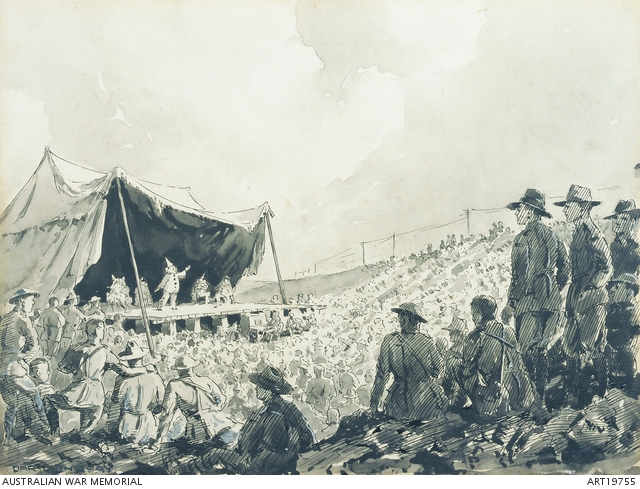| Place | Oceania: Australia, Victoria |
|---|---|
| Accession Number | ART19755 |
| Collection type | Art |
| Measurement | Overall: 21.1 x 28.2 cm |
| Object type | Work on paper |
| Physical description | pen, brush and ink with wash, heightened with white over pencil on cardboard |
| Maker |
Lindsay, Daryl Ernest |
| Place made | Australia: Victoria, Melbourne |
| Date made | c 1921 |
| Conflict |
Period 1920-1929 First World War, 1914-1918 |
| Copyright |
Item copyright: © Australian War Memorial This item is licensed under CC BY-NC
This item is licensed under CC BY-NC
|
Visit of 27th New York Divisional Concert Party to second FA Bde, Blaringhaim Canal, France, drawing for illustration in The Rough YM Bloke

Depicts an outdoor theatre with a visit of 27th New York Divisional Concert Party to second Field Artillery Brigade at Blaringhem Canal, France. Daryl Lindsay was the youngest member of the talented Lindsay family that included the artists Lionel, Norman, Percy and Ruby. He did not start painting until he was 30 years old and prior to this worked in a bank and from c. 1906 as a jackeroo and overseer in Queensland and Victoria before enlisting in the Army in 1915. He was a painter, illustrator and gallery director. He served in France as a Private in the Army Service Corps and as a driver and in 1917 at the Divisional Headquarters with official war historian and correspondent C E W Bean. Early in 1918 Lindsay began working as an Official Medical Artist attached to the Queen's Hospital at Sidcup in Kent, England. Here he produced medical illustrations for plastic surgery and a chance meeting with Henry Tonks, the Slade Professor at the University of London, encouraged Lindsay to pursue a painting career and to study at the Slade School of Art. After the First World War, Lindsay returned to Melbourne in 1919 and worked as an illustrator for journals such as 'Table Talk' and the 'Herald' and as a poster designer. In 1939 he was appointed Keeper of Prints at the National Gallery of Victoria, a post he held until 1942 when he was appointed director of the gallery (until 1956). During the Second World War, he was involved in Australian camouflage arrangements and travelled to the United States to 'report on management and arrangements of overseas galleries'. In 1956 he was knighted in recognition of his contribution to Australian art and received an honorary doctorate from the Australian National University in 1957. He died at Mornington, Victoria in 1976.